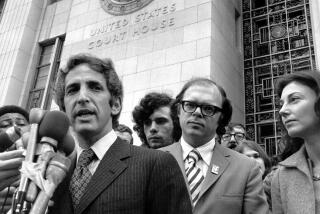A Tortured Past
In early 1973, Army Chief of Staff Gen. Creighton Abrams received some bad news from the service’s chief of criminal investigations.
An internal inquiry had confirmed an officer’s widely publicized charge that members of the 173rd Airborne Brigade had tortured detainees in Vietnam.
But there was a silver lining: Investigators had also compiled a 53-page catalog of alleged discrepancies in retired Lt. Col. Anthony B. Herbert’s public accounts of his war experiences.
“This package provides sufficient material to impeach this man’s credibility; should this need arise, I volunteer for the task,” wrote Col. Henry H. Tufts, commander of the Army’s Criminal Investigation Division.
Now, declassified records show that while the Army was working energetically to discredit Herbert, military investigators were uncovering torture and mistreatment that went well beyond what he had described.
The abuses were not made public, and few of the wrongdoers were punished.
Tufts’ agents found that military interrogators in the 173rd Airborne repeatedly beat prisoners, tortured them with electric shocks and forced water down their throats to simulate the sensation of drowning, the records show.
Soldiers in one unit told investigators that their captain approved of such methods and was sometimes present during torture sessions.
In one case, a detainee who had been beaten by interrogators suffered convulsions, lost consciousness and later died in his confinement cage.
Investigators identified 29 members of the 173rd Airborne as suspects in confirmed cases of torture. Fifteen of them admitted the acts. Yet only three were punished, records show. They received fines or reductions in rank. None served any prison time.
The accounts of torture and the Army’s effort to discredit Herbert emerged from a review of a once-secret Pentagon archive.
The collection — about 9,000 pages — was compiled in the early 1970s by an Army task force that monitored war crimes investigations. The files, examined recently by the Los Angeles Times, include memos, case summaries, investigative reports and sworn witness statements.
Those and related records detail 141 instances of detainee and prisoner abuse in Vietnam, including 127 involving the 173rd Airborne.
The Army task force, created after journalist Seymour Hersh exposed the 1968 My Lai massacre, served to give military brass and the White House early warning about potentially damaging revelations.
The war crimes records were declassified in 1994 and moved to the National Archives in College Park, Md., where they went largely unnoticed.
The Times examined most of the files before officials removed them from the public shelves, saying they contained personal information that was exempt from the Freedom of Information Act.
Other records were taken by Tufts in the 1970s and donated after his death to the University of Michigan.
The two collections do not provide a complete accounting of prisoner abuse during the Vietnam War. They contain only cases reported to military authorities and flagged for special attention by the Army chief of staff’s office or taken home by Tufts. But they represent the largest pool of such records to surface to date.
Retired Brig. Gen. John H. Johns, a Vietnam veteran who served on the task force, said the files provided important lessons for dealing with the prisoner abuse scandal in Iraq.
“If we rationalize it as isolated acts, as we did in Vietnam and as we’re doing with Abu Ghraib and similar atrocities, we’ll never correct the problem,” said Johns, 78.
A Supersoldier’s Charges
A coal miner’s son, Anthony Herbert was one of the most decorated U.S. soldiers of the Korean War. He went on to become an Army Ranger and a Ranger instructor.In 1968, he was promoted to lieutenant colonel, and in early 1969 was awarded command of a battalion in the 173rd Airborne.
The brigade was based in Binh Dinh province in the central coastal region when Herbert arrived. Over the next two months, his unit reported more enemy contacts than any other battalion in the 173rd Airborne.
Then on April 4, 1969, Herbert was relieved of his command for allegedly unsatisfactory performance. He later told investigators from the Criminal Investigation Division that, before his removal, he had informed his superior of war crimes that he had witnessed.
Herbert recounted a series of atrocities.
He said South Vietnamese troops had executed detainees in the presence of an American military advisor in February 1969. One of the victims had her throat slit as her child clung to her pant leg, Herbert said. (Investigators later concluded that about eight detainees had been slain.)
The following month, U.S. and Vietnamese interrogators tortured a teenager or young woman by electric shock and subjected a male detainee to water torture, Herbert said. He said he also saw interrogators beat two Vietnamese women held in metal storage containers.
Herbert told the investigators that he had reported these incidents to Col. J. Ross Franklin. On learning of the allegations, then-Army Chief of Staff Gen. William C. Westmoreland ordered Tufts to create a task force to conduct the investigation.
Before it was finished, Herbert took matters into his own hands and brought charges against Franklin and his superior, Maj. Gen. John W. Barnes, in March 1971, saying they failed to investigate reports of war crimes.
As Army officials feared, the case received widespread coverage because of Herbert’s distinguished combat career and Barnes’ rank, and because Franklin had served on the commission investigating the My Lai massacre.
Herbert achieved celebrity status as the case played out in the media. He appeared on “The Dick Cavett Show,” was interviewed by Playboy magazine and was featured in a New York Times Sunday magazine article titled: “How a Supersoldier Was Fired From His Command.”
Barnes and Franklin denied that Herbert had reported war crimes to them. According to news reports at the time, Barnes told an investigator he removed Herbert as battalion commander because he was “a keg of dynamite” who was “completely oriented to killing mercilessly.”
The Army dismissed the charges against Barnes and Franklin, and removed Herbert’s negative performance review.
Nevertheless, Herbert continued to accuse military leaders of a coverup. The Army responded by releasing “fact sheets” that said the investigation had substantiated only seven of 21 allegations by Herbert and had found no evidence that his superiors knew about them or retaliated against him.
In February 1972, Army magazine said that Herbert’s “eminence is undeserved” and devoted six pages to the fact sheets.
Herbert retired from the Army, citing harassment and strain on his family.
In January 1973, his memoir, “Soldier,” hit the bookstores, and the Army’s public information office scoured its pages for inconsistencies, records show.
Around the same time, the Army leaked internal reports on Herbert to CBS News, according to an Army memorandum. The TV news magazine “60 Minutes” aired a segment on Feb. 4, 1973, that attacked Herbert’s claims of coverup and retaliation.
Unknown to the public, Army investigators probing Herbert’s charges had learned that abuse of detainees by soldiers of the 173rd Airborne was much more extensive than he had alleged.
When contacted recently at his home in Colorado, Herbert declined to be quoted about the Army investigation, except to say: “If they’d really taken action about the bad apples and been honest about it then they wouldn’t be arguing about Abu Ghraib and different places today.”
Earlier Reports
The problem centered on the brigade’s 172nd Military Intelligence Detachment, known as the 172nd MI.Reports that interrogators in the unit were torturing prisoners had begun to surface several years before Herbert first made his allegations.
Among the first to speak out was Peter N. Martinsen, an interrogator from another unit who had worked with members of the 172nd MI. Testifying at the International War Crimes Tribunal, an unofficial forum in Stockholm, in 1967, Martinsen said he had taken part in beatings, and witnessed the use of field telephones to shock prisoners.
Army investigators interviewed him in November 1968. He requested immunity, but the Army’s office of the judge advocate general rejected the request, citing “the general nature of the allegation, Mr. Martinsen’s attitude and his record,” documents show.
Martinsen refused to give a statement. Efforts to reach him for comment for this article were unsuccessful.
Investigators marked his allegations “unsubstantiated” and closed their inquiry.
At the time of Martinsen’s interview, Robert Stemme Jr. was serving in the 172nd MI’s counterintelligence section. His job was to gather information about the enemy from friendly local sources, such as hamlet officials.
He did not conduct interrogations, he said in a recent interview, but he heard and saw them. Interrogations were conducted around the clock in a building about 10 yards from the tent where he slept, he said.
“My bed was maybe 30 feet from where all this stuff was going on. So I could hear this all night long,” Stemme told The Times. “It was pretty standard practice that people got slapped around or hit with things, or guns pointed at them, or whatever. Field telephones — all those things — were tools of the trade.”
The telephones had hand cranks that could be turned to generate electricity and two wires that could be attached to sensitive parts of a prisoner’s body. The shock could be intensified by wetting detainees and placing them in contact with metal objects.
In the spring of 1969, about a dozen members of the 172nd MI organized a letter-writing campaign to complain to higher-ups about the abuse, Stemme said.
“Next thing we know, we have this major coming up from IG’s office who is Miranda-izing us and asks us if we’re admitting to committing war crimes,” Stemme said, referring to the inspector general. “It was all about us, when this was de facto command policy. It was really scary.”
They decided as a group not to give any statements, he said.
Stemme returned to the United States in June 1969, and left the service in 1970. In April of that year, he spoke out about prisoner abuse at a news conference at the Greater Los Angeles Press Club. Martinsen and Frederick Brown, another former interrogator with the 172nd MI, joined him.
Army investigators contacted Stemme and Brown that summer. Brown told them that he and others “participated in water-rag and field telephone interrogations of detainees,” according to an investigator’s summary. Brown, who lives in Orange County, declined to be interviewed for this article.
Stemme met with Army agents in San Francisco. According to an agent’s statement, Stemme described abuse of detainees by 11 members of his unit over 12 months beginning in June 1968.
Under oath, Stemme said he saw interrogators punch and kick prisoners, beat them with sticks, administer electrical shocks and urinate on them.
Records show that Stemme detailed specific instances of maltreatment, offering names and approximate dates. Yet a case summary produced by the Army chief of staff’s office reported that investigators closed the investigation because Stemme “declined to provide any specific information concerning his allegations.”
“I spent hours with these guys,” said Stemme, now 63 and retired from his job as an investigator for the San Francisco public defender’s office. “There was no reason for me to be reticent.”
Interrogation Methods
Stemme identified former Staff Sgt. David Carmon as one of the interrogators who had tortured detainees.Herbert also accused Carmon of subjecting a detainee to water torture. Herbert said he found Carmon involved in the torture of a Vietnamese man, pouring water onto a rag placed over the captive’s nose and mouth.
This technique, called the “water rag,” causes a drowning sensation and is banned under international law. Bush administration officials have come under pressure in recent years to explicitly denounce a similar method known as “water-boarding” as an interrogation technique. In May, a Pentagon official told the United Nations Committee Against Torture that the revised Army Field Manual now specifically prohibited water-boarding. On Friday, a spokesman said the U.S. Army did not permit water-boarding — in past wars or as part of today’s intelligence-gathering procedures.
When investigators questioned Carmon in December 1970, he admitted using the water rag on a detainee, records show.
“I held the suspect down, placed a cloth over his face and then poured water over the cloth, thus forcing water into his mouth. The suspect, after becoming choked on the water, confessed that he was a VC and stated he was a propaganda man,” Carmon said, according to his sworn statement.
He admitted using electrical shock on detainees, the investigators’ summary states.
Carmon also told investigators that in the fall of 1968, he took part in interrogating a captive who died soon afterward.
The man had been “beat and kicked,” lost consciousness and suffered convulsions, according to summaries of statements given by members of the 172nd MI. A doctor was brought in to examine the detainee, identified as Nguyen Cong, and said there was nothing wrong with him, the records say.
Carmon said he and another member of the military intelligence team “slapped the Vietnamese and poured water on his face from a five-gallon can,” according to the investigators’ summary
Nguyen passed out “and was carried to the confinement cage where he was later found dead,” according to a May 1971 Army report. The investigators’ summary said the cause of death was listed in a hospital log as a ruptured spleen, probably due to malaria.
In a 1973 memo to Army Chief of Staff Abrams, Tufts said “maltreatment was not established as the cause of death.”
Reached by e-mail in Ohio, Carmon told The Times that abuse of prisoners was widespread in Vietnam and was encouraged by officers.
“Nothing was sanctioned,” he wrote, “but nothing was off-limits short of seriously injuring a prisoner.”
In another e-mail, he described the electric shock technique:
“What I saw were leads hooked to the legs of a metal folding chair. It was primarily used with the mountain/country detainees that weren’t familiar with electricity. They would [tell] them it would make them sterile or something to that nature. When you turned the phone crank, a light tickle of electricity would generally scare them into talking.”
He added: “I am not ashamed of anything I did, and I would most likely conduct myself in the same manner if placed in a Vietnam-type situation again.”
Part of a Pattern
Investigators contacted 31 members of the 172nd MI before submitting a report to headquarters that detailed a pattern of “cruelty and maltreatment” from March 1968 to October 1969.The report said the evidence warranted formal charges against 22 interrogators, some on active duty at the time. It concluded not only that interrogators repeatedly abused prisoners, but that the unit’s executive officer, Capt. Norman L. Bowers, had been present during some of the torture incidents.
Yet none of the interrogators nor Bowers was punished, records show. The three soldiers who were disciplined for mistreating detainees served in other units of the 173rd Airborne.
In an interview with The Times, Bowers said he had not witnessed or approved abuse of prisoners, contrary to what his subordinates said.
“It could likely happen, and I wasn’t told about it,” he said. “Mistreatment of prisoners is a very serious issue, and it’s not something someone’s going to bring to my attention.”
Bowers, now 67 and living in Missouri, said the men may have falsely accused him in hopes of getting him removed because they were working long hours.
“There was a lot of stress on people,” he said.
J. Ross Franklin, one of the two superiors whom Herbert accused of covering up war crimes, was deputy commander of the 173rd Airborne from December 1968 to June 1969.
In a recent interview, he said that he was not aware of the investigators’ findings, and that no one had ever reported prisoner abuse to him.
“I didn’t even know what water-boarding was,” said Franklin, now 78 and living in Florida.
He said he did not recall the letter-writing campaign or the nighttime beatings that Stemme described. He said he was housed in an officers’ area, in a structure with air-conditioning. “I really wouldn’t hear much of anything, other than friendly ‘arty’ shooting once in a while,” he said, referring to artillery.
He added: “Interrogators obviously are under pressure and encouraged to get information, and some of these guys are sadistic at heart. I wouldn’t bet my soul that it didn’t happen in the 173rd . If the Army found it, I’d say it probably happened.”
Times researcher Janet Lundblad contributed to this report.
*(INFOBOX BELOW)
About this report
Deborah Nelson, who wrote these articles, is a former staff writer and Washington investigative editor for The Times. Nick Turse is a freelance journalist living in New Jersey.
This report is based in part on records of the Vietnam War Crimes Working Group, on file at the National Archives in College Park, Md. The collection includes 241 case summaries that chronicle more than 300 substantiated atrocities by U.S. forces and 500 unconfirmed allegations.
Turse came across the collection in 2002 while researching his doctoral dissertation for the Center for the History and Ethics of Public Health at Columbia University.
Turse and Nelson also reviewed Army inspector general records in the National Archives; FBI and Army Criminal Investigation Division records; documents shared by military veterans; and case files and related records in the Col. Henry Tufts Archive at the University of Michigan.
The reporters and Times photographer Damon Winter traveled to Vietnam in the spring to visit the sites of incidents described in Army records and to interview victims’ relatives. Times researcher Janet Lundblad contributed to the report.
A selection of documents used in preparing this report, and previous articles on this topic, can be found at latimes.com/vietnam. Nelson’s e-mail address is dnelson@jmail.umd.edu.
More to Read
Sign up for Essential California
The most important California stories and recommendations in your inbox every morning.
You may occasionally receive promotional content from the Los Angeles Times.










